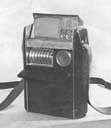The Classic Tricorder
By Richard A. Coyle
 The
Classic Tricorder was never intended to be the "Everything" machine
it ended up being. Its first mission priority (cinematically,
at least) was merely to justify the accompaniment of the enticing Yeoman Rand
with the Trek landing parties. It
is well established in futuristic space lore that there is no real reason you
would take a pretty girl along unless she had a good reason to come; ergo, she
needed a Tricorder. Not surprisingly,
its name really covers what it was originally intended to accomplish from a
technical mission standpoint, which was to record the mission, in (1) picture,
(2) sound, and (3) sensor. Thus, there were three recorder functions for the tricorder.
Later, with the departure of Grace
Lee Whitney, who played Yeoman Rand, and with budget problems that seem to be
endemic to television sci-fi series, the lowly tricorder became the answer to
every question: the problem solver, sensor reader, computer library...you name
it; the tricorder could do it. In the biz, it is know as a plot development
device, -- something to move the
story along easily and quickly.
The
Classic Tricorder was never intended to be the "Everything" machine
it ended up being. Its first mission priority (cinematically,
at least) was merely to justify the accompaniment of the enticing Yeoman Rand
with the Trek landing parties. It
is well established in futuristic space lore that there is no real reason you
would take a pretty girl along unless she had a good reason to come; ergo, she
needed a Tricorder. Not surprisingly,
its name really covers what it was originally intended to accomplish from a
technical mission standpoint, which was to record the mission, in (1) picture,
(2) sound, and (3) sensor. Thus, there were three recorder functions for the tricorder.
Later, with the departure of Grace
Lee Whitney, who played Yeoman Rand, and with budget problems that seem to be
endemic to television sci-fi series, the lowly tricorder became the answer to
every question: the problem solver, sensor reader, computer library...you name
it; the tricorder could do it. In the biz, it is know as a plot development
device, -- something to move the
story along easily and quickly.
 Now
to the details. Unlike the common versions seen at your local Star Trek Conventions,
these were not made of vacuum formed plastic. The only part that was vacuum formed on
each model was the hood. Many had
fiberglass doors and side
Now
to the details. Unlike the common versions seen at your local Star Trek Conventions,
these were not made of vacuum formed plastic. The only part that was vacuum formed on
each model was the hood. Many had
fiberglass doors and side  panels, with plastic over a wood back. Many did not even have opening doors, and some had only the
top small door that would open. These were made in a hurry for low dollars,
and when you see a real one you can see that.
They are ratty, bent, poorly fitted things, and many fans would have
passed these up sitting on a table, thinking some kid hacked them together in
his basement, and that surely such heaps could not be a real live TV prop.
panels, with plastic over a wood back. Many did not even have opening doors, and some had only the
top small door that would open. These were made in a hurry for low dollars,
and when you see a real one you can see that.
They are ratty, bent, poorly fitted things, and many fans would have
passed these up sitting on a table, thinking some kid hacked them together in
his basement, and that surely such heaps could not be a real live TV prop.
 Another
detail often incorrectly “replicated” was the color of the tricorder
indicator lights. In real Trek, the three rhinestones were
only blue -- not yellow, red, and blue as many have done -- just three blue
rhinestones.
Another
detail often incorrectly “replicated” was the color of the tricorder
indicator lights. In real Trek, the three rhinestones were
only blue -- not yellow, red, and blue as many have done -- just three blue
rhinestones.
 The
hood had an aluminum plate with a cutout shaped like a then current TV screen. They even vacuum formed a small clear
plastic face to match the shape of a picture tube from those days!
The
hood had an aluminum plate with a cutout shaped like a then current TV screen. They even vacuum formed a small clear
plastic face to match the shape of a picture tube from those days!









